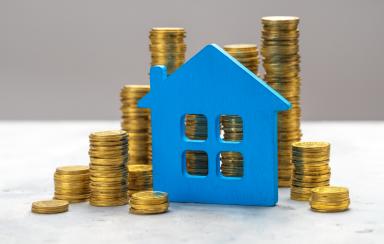Home Equity Loans Versus Cash-Out Refinance

A home equity loan is a lump sum paid back in fixed installments. A home equity loan (HEL) permits you to borrow money using the equity in your home as collateral. The house secures the loan, and you'll make payments over a fixed term with a fixed interest rate. A home equity loan is often a better option for those who need a large lump sum of money and prefer a fixed interest rate and repayment term. However, a HELOC is a HEL loan with an open-end line of credit with a mortgage tied to your property with a draw period. HELOCs allow you to borrow what you need, repay it, and then borrow again. A HELOC may be a better option for those needing flexible funds access over time and can handle a variable interest rate.
Unlike home equity loans and lines of credit, cash-out refinance replaces your existing mortgage with a new one, including a higher principal balance. The new mortgage amount is the remaining balance plus what you've taken out in home equity. After you close, your lender will send you the remaining cash to utilize however you want.
According to the Federal Housing Finance Agency (FHFA) 's 2023 Foreclosure Prevention and Refinance Report, 35% of loan modifications completed in the first quarter of 2023 have decreased borrowers' monthly payments by more than 20%. However, interest rates will remain relatively high in 2023. Whatever your personal and external financial situation, you must consider all options available to secure all aspects of your home’s mortgage costs.
Will Mortgage Rates Go Down in 2023?
According to the FHFA, the average monthly rate on Mortgage rates steadily edged higher in July 2023, averaging at 6.95%. Mortgage rates are likely to decrease significantly in 2023, although they're unlikely to return to the levels of the pandemic years of 2020 and 2021. Economists at Freddie Mac predict that while inflation is lessening, falling to its lowest annual rate in more than two years, the increases in housing costs remain high due to low inventory levels relative to their demand.
Mortgage rates for the 2023 year have bewildered many homeowners for their unpredictability. While it was originally anticipated that mortgage interest rates would decline, as of July 2023, they are on the rise.
Is 2023 a Good Time To Refinance a Mortgage?
If you are one of the homeowners who secured their mortgage rate at less than 6% before 2023, there may be a better time to refinance your mortgage. Many economists at Freddie Mac financial company predict that the fixed mortgage rate will average around 6.5% for the remainder of the year. However, everyone's situation and needs are different. Many homeowners have built up their home equity over the years due to the rapid growth of home prices, and refinancing remains one of their primary goals.
Home Equity Line of Credit (HELOC)
With a HELOC, the borrower can access a line of credit and draw on it as needed. A home equity loan (HEL) permits you to borrow money using the equity (current value minus the amount of any existing mortgage). Unlike HELs, the funds can go toward any expense. A HELOC is a secured loan, meaning lenders require that you put up collateral (in this case, your home) to secure the loan. Because your home is used as your HELOC collateral, the lender can take possession of your home if you default on the loan.
1. Closing Costs
Some lenders offer both home equity loans and HELOCs without closing costs. These options can be appealing if you need more cash to pay upfront fees or want to save as much money as possible.
However, in some cases, closing costs will apply. Closing costs on a home equity loan can range from 2% to 5% of the loan amount or line of credit. For example, if a HELOC loan charges $900 less in closing costs than another but has a $300 yearly fee while another option may have none, you may be financially better off with the second choice if you plan to use the HELOC for over five years.
2. Interest Rates
In general, HELOCs can offer a lower starting interest rate than HELs. However, you may be subject to higher closing cost fees. The interest rate for the loan duration is based on a percentage of the home's appraised value minus the amount still owed on the mortgage.
However, this rate is subject to change based on the current economic landscape. HELOCs have variable interest rates, meaning the rate you initially receive can rise or fall during your withdrawal and repayment periods. If the rate changes, your payments remain the same but will switch allocation (if the rate increases, more of your payment goes toward interest; if the rate decreases, less of your payment goes toward interest).
As of now, home equity rates will remain elevated in 2023. At the beginning of July 2023, rates for 10-year HELOCs were up again, landing at approximately 8.01% and 8.15% for 20-year contracts. However, some lenders offer options to convert all or part of your variable-rate HELOC into a fixed-rate HELOC (sometimes) for an additional fee.
3. No Restrictions
Lenders do not enforce restrictive covenants on how you can use your HELOC funds. But since your home is collateral for the loan, some uses are wiser than others. While you can allocate your funds however you like, using a HELOC loan to pay off credit card debt, purchase a car, or fund any vacations is not an advisable move.
4. Potential Tax Advantages
For home equity loans and lines of credit, home equity debt has tax benefits that can reduce the overall cost of a home or improvement project. You can deduct your interest on up to $750,000 for married filing jointly and up to $375,000 for couples who are married filing separately.
However, the loans must be within the agreed-upon loan limits, and you must provide proof that you used the funds for buying, building, or improving a home. The funds you receive from your lender must be used on the property for which the line of credit was opened. Your interest may not be deductible if you use the funds on other personal projects.
5. Draw Period
A HELOC draw period is the stage of a home equity line of credit in which you can borrow up to a certain amount while only making interest payments on the amount you borrow. It typically lasts five to ten years, though this varies on loan criteria and lender. Once the draw period ends, you can no longer take cash out, and the repayment period begins.
6. Repayment Periods
The repayment period of a HELOC loan is when you make a monthly principal (meaning, the amount you borrow from a lender) and interest payments to your lender—usually throughout 10 to 20 years, though this varies based on loan criteria and lender. Charges are not optional during repayment periods.
The transition from the draw period to the repayment period is automatic. So, once you've finished month 120 (if you have a 10-year draw period), your HELOC will rotate into the repayment period, and you'll start repaying your balance.
7. Caps on Rate Increases
HELOCs must offer a lifetime rate cap that limits how much the loan rate can change over time. According to the Federal Reserve, your interest rate can only rise a certain amount during the loan term. Some lenders limit how much your rate can increase at each adjustment, and others may have a floor, which sets the lowest rate if the index rate (meaning, the benchmark interest rates reflecting general market conditions) falls.
Cash-Out Mortgage Refinance
A cash-out refinance is a type of mortgage that takes advantage of the equity you've built over time and gives you cash in exchange for taking on a larger mortgage amount. You use the loan to repay the original mortgage; the remaining money is yours to do as you please. You can borrow up to 80% of your home's equity.
Some homeowners use these funds to consolidate debt, fund home improvement projects, and invest in rental properties. This process works by replacing your existing mortgage with a new one featuring a higher principal balance. The new mortgage amount is the remaining balance plus what you've taken out in home equity. After you close a cash-out refinance, your lender will send you the amount you want to utilize from your home equity.
1. Access to Large Loans
Unlike a home equity loan or HELOC, A cash-out refinance allows you to use your home equity funds for anything. You can pay off credit cards, student loan debts, and other personal endeavors, such as financing a new vehicle. To calculate the amount of money that you could receive from a cash-out mortgage refinance, consider the following components:
How much is owed on a mortgage (mortgage balance)
How much your home is worth (property value)
How much equity your lender requires you to have (retained equity)
2. Lower Interest Rates
While the difference isn't extraordinary, cash-out refinance rates are higher than their rate-and-term counterparts. Lenders consider a cash-out refinance relatively higher risk than other loan counterparts because it leaves you with a larger loan balance than you had previously and a smaller equity cushion.
3. Potential Impact on Credit Scores
Mortgage refinancing can affect your score for the worse (depending on your financial situation), so it's wise to take some precautions. If you do a cash-out refinance and use the funds to pay off debt, you could see a boost to your credit score if your credit utilization ratio drops. Credit utilization, or how much you're borrowing compared to what's available, is a critical factor in your score.
4. Potential Tax Deductions
The most significant tax deduction homeowners usually qualify for is the mortgage interest deduction on their original loan and refinance. However, special rules apply for deducting interest on a cash-out refinance. Renovations can also affect how you file your taxes. In general, you can remove the interest you pay on the mortgage if you use the money to make improvements that add value to the home.
Questions to Ask Before Refinancing
There are many factors to consider when thinking about refinancing your mortgage. The following questions will help guide you through what folks typically ask themselves before doing so.
1. What Are Your Intentions For Refinancing?
Before employing the services of HEL or HELOC, or cash-out refinancing, you should consider your goals for refinancing. Are you trying to pay off your mortgage sooner? Lower your monthly payment? Access your home's accumulated equity? Whatever you hope to accomplish will determine what interest rates and loan terms to look for.
2. How Much Equity Do You Have in Your Home?
You need at least 20% equity in your home to qualify for a new loan without paying private mortgage insurance, so aim for that percentage if you are looking to refinance. If you need more than 20%, speak to your lender about different federal loans that may help lower your payment.
3. What is the Current Value of Your Home?
It is crucial to understand your home’s total equity. You can find out approximately what your home is worth by checking out the sale prices of similar homes in your neighborhood. You can do so via an online service or by contacting a realtor.
4. How Long Do You Plan to Live in Your Home?
Refinancing may make sense if you expect to stay in your home for an extended period (five years or longer). If you plan to move soon, you may need more time to recoup the costs of refinancing the mortgage. Homeowners must wait at least seven months before refinancing their mortgage, and any payments they make within the 12 months must have been paid on time.
5. What Are the Terms of Your Current Mortgage?
The term of your loan is how long you have to repay the loan, affecting your interest rate, your monthly interest and principal payment, and how much interest you will pay over the loan term. It is crucial to understand these terms to determine the loan or refinancing option best fit for you.
6. What Are the Current Interest Rates?
Generally speaking, consider refinancing if you can get an interest rate of at least 2 percent below your original loan rate. However, you may also want to refinance if you have an adjustable-rate loan or are concerned about future rate fluctuations and want to switch to a fixed-rate loan.
7. Do I Qualify For A Mortgage Refinance?
To qualify for a mortgage loan or refinance, you must meet the following requirements:
An Adequate Credit Score
You must meet specific credit and lending requirements to qualify for your mortgage loan or refinance. You'll generally need a 620 credit score for a mortgage refinance or loan. You'll also need to ensure that your debt-to-income ratio (DTI) meets any outstanding mortgage payments. In most scenarios, the highest DTI you can get still approved for refinancing is 43%.
Home Equity
You must have built up your home’s equity enough to qualify for a refinance. You should have at least 20% equity in your home if you want to refinance. To do a cash-out refinance, you must build up equity larger than 20%.
Required Documentation
You'll also need the following paperwork:
Employment information
Two recent pay stubs and W-2s.
Two recent tax returns
Proof of self-employment
Business Income
Credit Score
Property and Asset information
Homeowners Insurance
Debt statements
Closing disclosure form
How To Find a Mortgage Refinance Company
Mortgage refinance companies strive to align your mortgage goals with your financial reality. At Expertise.com, we are committed to linking you with mortgage professionals who meet your specific needs. Whether you are looking to refinance through HELs/HELOCs or by cashing out, please refer to Expertise’s directory to get connected today.
Expertise.com StaffAuthor
Step into the world of Expertise.com, your go-to hub for credible insights. We don't take accuracy lightly around here. Our squad of expert reviewers, each a maestro in their field, has given the green light to every single article you'll find. From rigorous fact-checking to meticulous evaluations of service providers, we've got it all covered. So feel free to dive in and explore. The information you'll uncover has been stamped with the seal of approval by our top-notch experts.

![The Best Mortgage Refinance Companies With No Closing Costs [2023] DUP IMAGE](https://images.ctfassets.net/k00sbju4hbzq/49QT5rcgTCbXVuaQTvpCGd/3127e458ad8c7d358765415e47accac7/Depositphotos_175405612_XL.jpg?fit=fill&w=384&q=75)


